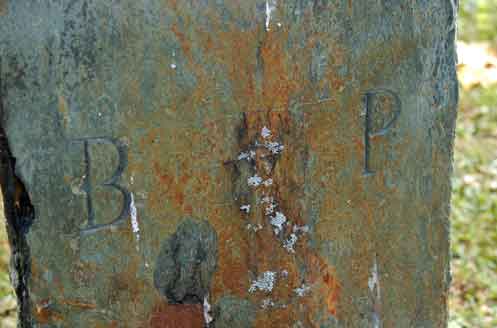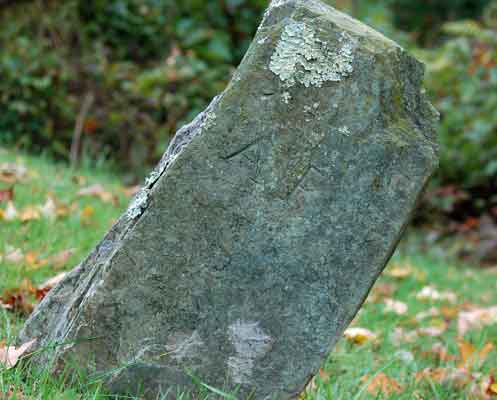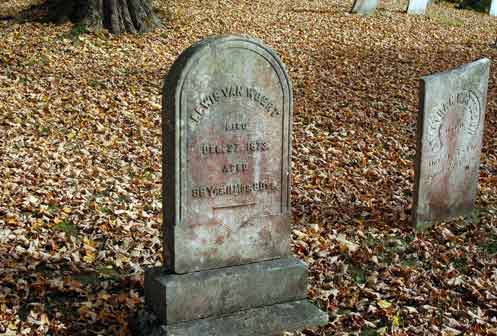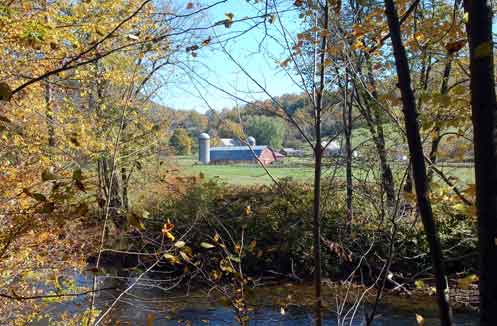Burial Landscapes of Colonial Dutch Settlers in Vermont
Patricia van der Spuy and Scott C. Roper, Castleton State College
Introduction
The year 2009 marks the four-hundredth anniversary of Henry Hudson’s voyage up the Hudson River and the beginning of New Netherlands. A scholarly revision is under way, including in its purview “the transference and then adaptation of Dutch culture to the New World” (Starna 2007).
Despite researchers’ renewed focus on Dutch settlement in North America, the Dutch presence in Vermont has not been well studied. Much of the research into the meanings and persistence of “Dutchness” in the late seventeenth and eighteenth centuries has focused on New York and New Jersey. Scattered internet sources refer to colonists from the van Rensselaer patroonship along the Hudson, Rensselaerswijck, settling in southwestern Vermont before 1730, as well as to an early trading post set up along Lake Champlain. Few traces of Dutch colonial settlement remain east of the Hudson–but enough to motivate the identification and preservation of such sites where they are found.
This paper represents our attempt to locate traces of Dutch colonial settlement in Vermont. Because graveyards are conservative, long-lasting material records of culture (Jordan 1982, 6-7; Hannon 1989, 237), we have chosen to search for, identify, and record existing colonial Dutch burial landscapes in Vermont. We describe our successes and failures in that search herein.
The Global Context
This project is part of a larger, long-term comparative study of Dutch burial patterns in Africa and the Hudson Valley, and represents our first attempt to undertake such analysis in Vermont. Our broader study seeks to compare the imprint of colonial Dutch material culture on the landscapes of South Africa with those in North America, beginning with Vermont and tracing our way back through New York and New Jersey across the Atlantic Ocean to South Africa, the site of the Dutch East India Company’s colony.
Striking similarities in the descriptions of colonial Dutch domestic or household culture between these far-flung regions led us to ask questions that might help us to trace the connections that may well have remained between the Dutch settlers in Vermont, and those back on the Hudson. The role of the Dutch Reformed Church seems to have been as strong in New Netherlands as it was in the Cape Colony, where it dominated the annual life patterns of boers/farmers/settlers who had moved away from the center of Dutch colonial culture, Cape Town. We found no Dutch Reformed churches in Vermont, but this does not necessarily point to an erosion of Dutch religious identity. In South Africa, it was not considered necessary to build Dutch Reformed churches in the hinterland (although some communities did), because one of the key functions of the Moederkirk (Mother Church) in Cape Town was to control the crucial life transitions of baptism, marriage, and death—or more specifically for our purposes, burial. Our research will examine the extent to which those who lived far from Cape Town were brought “home” to die and be buried— we do know that there was an annual trek to town to perform the necessary rituals of baptism and marriage, as well as stocking up on provisions. Transferring this pattern to Vermont, we hope to be able to establish whether similar cultural ties existed between Vermont and towns on the Hudson like Kingston that retained a strong Dutch identity.
The Dutch in North America
The narrative of the establishment of New Netherland in the service of the Dutch West India Company in the early seventeenth century is well known. Patroon Kiliaen van Rensselaer, whose patroonship, Rensselaerswijck, extended to both sides of the Hudson River, encouraged Dutch agricultural settlement in order to support the soldiers and traders of the Company (Jameson 1909). As Donna Merwick put it, “[t]he men who were the tillers of the soil (the boers, the farmers) were adjuncts to the Company and its objective at the fort: trading. They were to victual whatever numbers of soldiers and traders might live within the fort. Little more” (Merwick 1990, 7). She continues:
van Rensselaer wanted his farms west on the bank and north of Fort Orange for the same reason that he wanted the majority of his settlers on the east bank. ... He wanted his farm established where his overseer could forestall furs being carried to the Company’s traders at the fort, while he wanted those of his artisans and farmers erected at a distance from the same trade routes. Poest’s farm was the northernmost area under cultivation on the east bank of the river. It was also arable land on both sides of a kill, but its occupancy also had to do with the fur trade… (11).
Although farms were established on the east bank of the Hudson during van Rensselaer’s tenure, nearly half a century elapsed after the English takeover of New Netherland (in 1664) before towns were founded in what is now Vermont. Prior to Vermont’s declaration of independence in 1777 (and its later incorporation into the United States in 1791), the southwestern region of what we now know as Vermont came under the jurisdiction of New York, as Albany County, though nearly all of Vermont was claimed by both New York and New Hampshire. In 1771, New York conducted a census of Vermont, finding that only 23.1 percent of the population of Vermont (estimated at 7,664) lived in Albany county (Holbrook 1982, i-iii).
Although the Dutch colonies of the Mid-Atlantic already had absorbed Norwegian, Danish, German, Walloon, and French Huguenot colonists when the British took control of them in the late 1600s, and the Lutheran Church was exerting a presence in the region, the Dutch carefully maintained a separate identity from other European groups (Richards 2007, 26; Venema 2003, 21, 101-103; Swierenga 1985, 3). A sense of separateness defined early Dutch settlement, and scholars debate the extent and timing of the process of Americanization, whereby “Dutchness” became a specifically American-Dutch identity, or a more completely assimilated “Americanness.” Scholars agree on the importance of the Reformed Dutch Church to the definition of Dutch ethnicity. Firth Haring Fabend notes:
The first permanent settlers to New Netherland, equipped with Psalm books, the Reformed creeds and confessions, and the Heidelberg Catechism, arrived in 1624, accompanied or at least soon followed by a lay pastor known as a ziekentrooster, or comforter of the sick. By 1628 an ordained Reformed Dutch minister had organized a congregation and was conducting worship services in a room constructed for the purpose… . Three hundred years later, in the early 1900s. H. L. Mencken and other scholars found Dutch dialects still spoken within the boundaries of the original New Netherland, Dutch material culture and folkways abundantly evident, and the Reformed Dutch Church flourishing on the banks not only of the Hudson River, but all over New York and New Jersey, as well as in the Midwest (Fabend 2000, 1-2).
Even if “the Dutch immigrants reluctantly had to adapt gradually to American religious practices in order to survive” (Swierenga 8), the Reformed Dutch religion held the key to “rates of assimilation, in-group marriage practices, language retention, literature and periodicals, and the survival of an ethnic identity in America” (5).1 Fabend makes the important point that the intersection between “Dutchness” and “Reformedness” must be established historically. She points out that not all self-identifying Dutch in America had any necessary relation to the Netherlands, or to Dutch ancestry. However, irrespective of ancestry, a strong connection did exist for many to the Reformed Church (Fabend 9). Our question is, to what extent did those relatively few, relatively isolated, Dutch settlers in Vermont partake of the “flourishing” of Dutch culture that has been identified with a persistent religious Reformed identity?
Evidence of Reformed Dutch churches, architecturally and in terms of documentary evidence of liturgical praxis, provides critical clues to the existence and changing nature of Dutch ethnicity. Locating church buildings offers the hope of locating the traces of Dutch identity expressed through burial practices. We know that the Reformed Church in Kingston, New York was built directly on top of the burial ground associated with an earlier Reformed congregation, when the site was named Wiltwijck and Rondout, the location of the first permanent Dutch settlement. The cemetery markers in that graveyard can be traced back to the seventeenth century.
Historians of the Dutch in New York and New Jersey tend to rely on both documentary and other material culture in order to trace cultural patterns in New Netherland’s history. These studies are richly resourced; however, when one seeks to trace Dutch settlement and, more important, the evidence for the sustaining of Dutch cultural markers in Vermont, the clues become sparse. Where few traces are evident in architecture, and where church records do not exist, a crucial, at-risk material trace may exist in grave markers.
Brandon Richards notes that “[t]he colonial era gravemarkers of the upper Mid-Atlantic states have been the focus of limited research to date. That which has been conducted primarily concerns the New York/New Jersey gravestone carving tradition, established prior to the 1720s” (Richards, 25). Early grave markers would have been made of wood, in which case they are unlikely to have survived, or they were “simple stone non-artisanal markers.” Richards’s research concerns the “rough-hewn stone traditions of colonial New York, New Jersey, and Delaware; more specifically, those markers erected by and for the descendants of the New Netherland colonists.” He points out that, despite researchers’ claims that the Dutch settlers did not use grave markers before the English annexation of New Netherlands, in fact:
centuries-old marker traditions were in use before English-inspired headstones were adopted. Unfortunately, most of the earliest markers have been lost over the centuries to development pressures, neglect, and misidentification. Because of this, the final resting places of many of America’s first colonists have been, and risk continuing to be, disturbed. It is therefore important that remaining early stones are properly identified, not only for their own archaeological significance, but also to protect the remains they mark (25).
For these reasons, and to contribute to the historical research into the “where” and “when” (or “how long”) of Dutch ethnicity in Vermont, our study extends the geographical reach of Richards’s research; by venturing into southwestern Vermont, we, too, seek evidence of “Dutch cultural area sites where there had been a history of cultural isolation” (25).
Dutch Landscapes in Vermont
Perhaps the best source of the colonial Dutch presence in Vermont remains the work of Stewart McHenry, who identified a possible Dutch presence in southwestern Vermont at least as early as 1724 (McHenry 1986, 118). In the absence of obvious Dutch landscape imprints, McHenry’s work was crucial in allowing us to narrow the geographical scope of our study. In his research, the geographer found a unique pattern of settlement and land subdivision among the Vermont Dutch. The Dutch tended to settle in floodplains and low terraces along rivers (115, 121). The irregularly shaped fields tended to be small (three to ten acres), oriented to rivers or adjacent roads, and uninterrupted by stone walls or tree lines (121). Ultimately, McHenry identified eight towns in which these patterns dominated and persist: Pownal, Pawlet, Rupert, Manchester, Sandgate, Arlington, Sunderland, and Shaftsbury, all near or along Vermont’s border with New York.
Based on this research and to better identify the locations of cemeteries, we consulted United States Geologic Survey 7.5-minute-series maps. Throughout most of region that McHenry identified as having been influenced by Dutch farmers, streams tend to flow westward, generally as part of the Hudson River drainage basin. Logically, Dutch settlers would have followed these streams and valleys into Vermont from the Hudson River, partially explaining the preponderance of Dutch farming patterns along the valley floors.
On the USGS maps, we noted remnant evidence of a Dutch influence in the region’s place names. For instance, the stream that flows through Manchester, Sunderland, and Arlington is named “Batten Kill,” and several mountains are called “Cobbles.”2 We also found at least two separate highland areas called “Dutch Hill,” and one road named “Dutch Lane.” On the basis of local place names, we added Poultney and Wells to our list of towns that may have been influenced by Dutch colonists. Other towns may have witnessed a Dutch presence as well, including Bennington, but apparently such settlement was too inconsequential to be “effective”—as in many other places, subsequent settlers from Connecticut, New Hampshire, and Massachusetts obscured or obliterated earlier cultural patterns here.
With locations identified, we still needed to consider exactly for what we were looking. To date, Richards’s 2007 study is the most comprehensive research into Dutch colonial burial patterns in the upper Atlantic states. Richards has found indirect evidence suggesting that the Dutch used burial markers in present-day Albany “in some form” prior to 1664, when the region came under British control, as well as direct evidence of such use in the Netherlands prior to that time (26-27). He suggests that the earliest markers used in New Netherlands probably were wooden, as they tended to be in the Netherlands (28-29).
By 1690, however, stone markers had appeared in Schenectady, and by the 1710s in Kingston, New York, usually in yards adjacent to Dutch Reformed churches. Typically, these markers are slanted or curved at the top, with very little information on them: initials, death dates, and other varying information given in abbreviated form (31).
Thus, for this project, we searched the ten towns we identified as possibly having been influenced by the New York Dutch during the colonial period. We searched nearly every graveyard we could identify on topographic maps, hoping to find markers similar to those described by Richards.
Findings
Although we planned to limit our search to cemeteries in river valleys, we considered some upland graveyards as well, particularly those located in hollows near the New York border. We were unable to gain access to a handful of cemeteries, including one in Manchester on private land and one in Poultney that does not seem to exist despite its presence on a USGS topographic map. In the end, our search produced only three sites worthy of mention in the context of this study: one each in Pownal, Poultney, and Shaftsbury.
Pownal, the southwestern-most town in Vermont, originally fell within the van Rensselaer patroonship. Although settled from New York in the 1730s, gravestone evidence suggests that English-surnamed colonists from New England overran the township at an early date. We investigated four cemeteries, both along the floodplain of the Hoosic River. (We could not gain access to a fifth cemetery located on private land adjacent to an abandoned dog-racing track.) Overall, we found only one grave site which could be Dutch or Dutch-influenced, though the date on the stone (1822) would seem remarkably late. Still, the top of the stone is angled, though not quite as steeply as those identified by Richards, and the marker contains minimal evidence—the year of death and the deceased’s initials (BP) and age at the time of death (52; figure 1). For reasons explained below, however, we do not believe that this stone is Dutch.

Figure 1. Gravestone at Pownal, 1822. All photographs by Scott Roper.
Poultney falls at the northern end of our study area, near Castleton. We investigated several graveyards in the town, but found only one within a reasonable distance of a small brook which feeds into the Poultney River. Even that cemetery is located in an upland area—in Fennell Hollow—and contains a plethora of stones with English surnames. We found one stone similar to that in Pownal, with the initials “AF,” though the top is barely angled and no date or age of death is apparent (figure 2). Again, for reasons explained below, we believe this stone to be Anglo-American rather than Dutch.

Figure 2. Undated gravestone at Poultney.
Finally, we found one identifiably Dutch name in a graveyard in Shaftsbury. Lewis van Wuert died in late 1873 at nearly 89 years old (figure 3). Clearly, this individual’s gravesite is too late to be a colonial Dutch grave site, besides which van Wuert’s name does not appear on federal census manuscript sheets for Shaftsbury until 1860—meaning he probably arrived in Shaftsbury from nearby New York quite late in life.

Figure 3. Van Wuert gravestone at Shaftsbury (1873).
With the exception of the Shaftsbury example, which clearly is not a “colonial” burial site and likely represents the final resting place of an American of Dutch ancestry, we determined that these examples are not remnants of “Dutch” settlement. Using manuscript sheets from the 1790 federal census, we found that identifiably Dutch surnames could be found in five of the towns in our study area, including Pownal, but not Poultney. Furthermore, Pownal’s Dutch population was vastly outnumbered by those with English surnames in 1790, and by 1820 had completely disappeared—meaning the 1822 gravestone is not likely to be Dutch. Thus, our search uncovered no colonial Dutch burial sites in southwestern Vermont.
Conclusions
Remnant Dutch colonial landscapes in Vermont are exceedingly difficult to find and identify. During our search for colonial Dutch burial sites, we also conducted an informal survey of the built landscape, paying particularly close attention to houses and barns. Our sense is that few, if any, truly “Dutch” buildings exist in Vermont today. We did find a surprising preponderance of English- and Erie Shore barns in western Vermont, many of which appear to have been built during the state’s changeover from a wool-producing economy to one based on dairy and specialty crops (figure 4). We found no identifiably colonial “Dutch” barns east of the Vermont-New York border (Noble and Cleek 2006, 107-108; 117-119). We were more fortunate in finding a handful of Dutch houses, some built of stone or brick and with side-gabled or parapeted roofs (McAlester and McAlester 1997, 112-119). All that we saw, however, date from the nineteenth or twentieth centuries, and provide no evidence of a Dutch presence during the colonial settlement period.

Figure 4. Barn with flared eaves in Sunderland, as seen from a cemetery on the opposite bank of a local brook. This style is typical of larger, later barns in the study area.
Even so, Dutch settlement was substantial enough to produce the field patterns identified by McHenry, not to mention remnant Dutch place-names, and settlers with Dutch surnames did live in the region prior to 1800. Why, then, did they leave behind so few grave sites, if any? We could think of two possibilities: either the landscapes left behind by Dutch settlers have deteriorated and disappeared, or relationships between Vermont and parent settlements on the Hudson River were such that the Dutch did not leave any landscapes of death in Vermont.
Either option is possible. If Dutch farmers in Vermont traveled to established Dutch Reformed churches for important life (and death) events, as was true in South Africa, then many of their final resting places probably are on church grounds in New York. On the other hand, if settlers were buried locally, any wooden markers established in the humid continental climate of Vermont would have decomposed after two and a half centuries. Stone markers may have met the same fate as those on colonial English gravesites, where brittle stone had split and worn away. Furthermore, according to Richards, the earliest markers in the Mid-Atlantic states “have been lost over the centuries to development pressures, neglect, and misidentification.” If some of Vermont’s Dutch farmers were buried on their land, later farmers may simply have disposed of extant grave markers and plowed the burial sites under for crops, as occurred along the Hudson River (Richards 25). A future investigation of Dutch settlers’ relationships with the Dutch Reformed Church in South Africa may provide a model for us to test in North America.
Notes
1 Suzanne M. Sinke notes, “[t]he predominant form of Dutch American ethnicity that developed in the United States, and particularly the variety of patriarchy it entailed, came out of the Dutch Calvinist tradition” (Sinke 2002, 1).
2 We also noted that many of the valleys carry the generic stem “Hollow,” a place-name that is almost entirely absent in New England outside of southwestern Vermont and the Massachusetts Berkshires, but much more common in New York. However, most of Vermont’s hollows are named with non-Dutch specific stems.
Works Cited
Fabend, F. 2000. Zion on the Hudson: Dutch New York and New Jersey in the Age of Revivals. New Brunswick, NJ: Rutgers University Press.
Hannon, T. 1992. “Western Pennsylvania Cemeteries in Transition: A Model for Subregional Analysis.” In R. Meyer, ed., Cemeteries and Gravemarkers: Voices of American Culture. Logan: Utah State University Press, 237-257.
Holbrook, J. 1982. Vermont 1771 Census. Oxford, MA: Holbrook Research Institute.
Jameson, J. F., ed. 1909. Narratives of New Netherland 1609-1664. New York: Barnes and Noble.
Jordan, T. 1982. Texas Graveyards: A Cultural Legacy. Austin: University of Texas Press.
McAlester, V., and L. McAlester. 1997. A Field Guide to American Houses. New York: Alfred A. Knopf.
McHenry, S. 1986. “Eighteenth Century Field Patterns as Vernacular Art.” In D. Upton and J. M. Vlach, eds., Common Places: Readings in American Vernacular Architecture. Athens: University of Georgia Press, 107-123.
Merwick, D. 1990. Possessing Albany, 1630-1710: The Dutch and English Experiences. Cambridge: Cambridge University Press.
Noble, A., and R. Cleek. 2006. The Old Barn Book: A Field Guide to North American Barns and Other Farm Structures. New Brunswick, NJ: Rutgers University Press.
Richards, B. 2007. “New Netherland’s Gravestone Legacy: An Introduction to Early Burial Markers of the Upper Mid-Atlantic States.” Markers XXIV, 25-39.
Sinke, S. 2002. Dutch Immigrant Women in the United States, 1880-1920. Urbana: University of Illinois Press.
Starna, W. 2007. “Encounters in New Netherland” (review essay). New York History 88:3 (http://www.historycooperative.org/journals/nyh/88.3/starna.html), last accessed October 10, 2008.
Swierenga, R., ed. 1985. The Dutch in America: Immigration, Settlement, and Cultural Change. New Brunswick, NJ: Rutgers University Press.
Venema, J. 2003. Beverwijck: A Dutch Village on the American Frontier, 1652-1664. Albany: State University of New York Press.

